This article was produced in partnership with Columbia Journalism Investigations, the Center for Public Integrity and Type Investigations.
SMITHFIELD, Va. — When flooding from Hurricane Floyd in 1999 destroyed Betty Ricks’ home, she rebuilt. Several years later, she posed proudly for a Christmas photograph beside her daughter and granddaughter in her new living room.
Then another flood — brought by Tropical Storm Ernesto in 2006 — claimed her house a second time, leaving soggy furniture and appliances jumbled sideways.
“Everything gone again,” Ricks said. The only thing she salvaged was the photograph, now water-streaked.
After that storm, she rebuilt her home from scratch once more. Yet more flooding followed.
Now, she and some of her neighbors on Great Spring Road, who live less than 30 miles inland from where the Chesapeake Bay opens into the Atlantic Ocean, see no way out of this dangerous loop but to move. With an increasing number of communities at high risk from worse and more frequent disasters fueled by the changing climate, experts warn that many Americans will find themselves in a similar situation.
But the only way to leave without putting new buyers in the same position — or abandoning their homes altogether — is to seek relocation funds from the federal government.
Twice now, Ricks and her neighbors have asked for that help.
Both times, their application was denied.
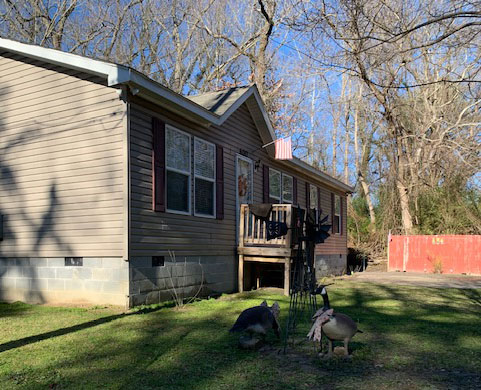
Betty Ricks’ home in Smithfield, Virginia. Image: Julia Shipley/Columbia Journalism Investigations
Columbia Journalism Investigations in partnership with the Center for Public Integrity and Type Investigations spent a year digging into the growing need for climate relocation across the United States. Little organized government assistance exists for preventing the loss of homes and lives before a disaster, the investigation revealed — and there is no comprehensive focus on helping people escape untenable situations like Ricks’.
For decades the federal government has known that climate change will force people in the U.S. to relocate. And the Government Accountability Office, Congress’s investigative arm, recommended in 2020 that the government form a “climate migration pilot program” to help people who want to relocate due to climate change — a recommendation it reiterated in March.
But in the absence of such a program, communities across the country must try to cobble together funding from across federal agencies through programs that weren’t designed for the climate crisis.
That leaves people in harm’s way to fend for themselves. Many can’t.
Columbia Journalism Investigations and its partners analyzed federal disaster declaration data over the past three decades to identify communities repeatedly hit by major hurricanes, floods or wildfires, events that climate change is worsening.
The analysis revealed dozens of communities across the country in recent years — and hundreds over the last generation — bearing the brunt of successive disasters, from California to North Carolina, Washington state to Texas. Many are located near the Atlantic, Pacific or Gulf coasts, but the impacts are also felt far from the shoreline, in Missouri, North Dakota, Kentucky and elsewhere. No region of the country has been spared.
What unites these pummeled communities is that they are often more socially and economically vulnerable than other places, the analysis revealed.
People of color make up more than half the residents in counties that experienced at least three climate disasters in the past five years. These counties also have a higher proportion of residents who speak limited English and people in poverty than the rest of the country.
The Federal Emergency Management Agency’s disaster preparedness spending — which includes money to help people relocate — already falls short of the need, experts say. And it’s not flowing out equitably, according to the analysis by Columbia Journalism Investigations and its partners.
Among hard-hit counties, places with a higher share of residents of color than the national average received about 40 percent less funding per person. A similar trend held over the last three decades.
Taken together, the findings highlight how, in the face of climate-driven disasters, communities across the country in the greatest need of government assistance receive less of it — if they get anything at all.
These challenges affect a large and growing number of people. In 2018, the government’s most recent National Climate Assessment warned that more than 13 million people across the country may need to move by the end of the century due to sea level rise. Add the effects of hurricanes, riverine flooding and wildfires, and millions more will need to seek out safer parts of the country — or remain trapped in damaged, dangerous conditions.
Take Smithfield.
Sea levels in this Hampton Roads region are rising faster than anywhere else along the Eastern Seaboard. Additionally, the land along the Virginia coast is slowly sinking, causing high tides to push water farther and farther inland. Along Ricks’ Great Spring Road, amid the region’s coastal floodplain, sudden heavy rains can cause water to rise up to seven feet in just an hour, turning the streets into rivers.
Ricks has been rescued by boat from her home twice.
The first of her unsuccessful attempts to move to a safer area came in 2010, when she and her neighbors applied for a federal buyout through Isle of Wight County, where Smithfield is located. For decades, FEMA has facilitated the purchase of flood-prone homes. Following the buyouts, the government demolishes the structures, returning the land to open space to stop the cycle of damage and loss.
On Ricks’ application, a hazard mitigation consultant attested that the grant “would eliminate the possibility that another homeowner will suffer the same misfortune as Mrs. Ricks.”
The state agency denied Ricks’ application for unknown reasons; according to one official, no documentation that could explain the decision could be located.
In 2020, in the wake of more severe storms, Smithfield officials tried again, applying for $920,240 in funding from FEMA to acquire and demolish Ricks’ home and four neighboring properties. The project would be “100% effective in preventing loss of property and life due to future flooding,” the town’s funding paperwork stated.
FEMA denied the request.
The money would have come from FEMA’s newly launched Building Resilient Infrastructure and Communities program, which allocated $500 million for disaster and climate change preparedness projects across the country. But Victoria Salinas, FEMA’s acting deputy administrator for resilience, said there wasn’t enough funding to help Smithfield in 2020.
Instead, assistance went to other communities such as Menlo Park, California, where the government provided $50 million to protect homes and businesses in and around Palo Alto, the heart of Silicon Valley. Across the country, requests for assistance exceeded $3 billion.
“We were oversubscribed,” Salinas said. “There are so many good projects that need to be funded, and communities want to invest in their resilience. They want to be making sure they’re safe today and tomorrow. There’s just not enough money on the streets to [fund them all].”
Ricks sees no way out without that help. She leaves the TV on in her bedroom, checking news broadcasts for warnings about incoming storms. She keeps important papers wrapped in plastic bags in a trunk at the foot of her bed, hoping that will be enough to save them when her home floods again.
Faced with intensifying hazards and a federal government failing to act, she asks a question with no clear answers:
“What am I going to do?”
No one-stop shop for climate relocation
The federal government knows that climate change will displace millions, but it has been slow to respond to the growing threat. A 2020 Office of Inspector General report criticized FEMA’s programs as inadequate. Other reports and experts have repeatedly called on Congress to designate a lead agency to oversee the complex process of relocating communities.
No single agency or program is responsible for helping Americans move to safer parts of the country, however.
“There’s not a one-stop-shop program for this,” Salinas said. “I think right now, what we do offer is pieces of it.”
Vulnerable Americans must navigate a bureaucratic labyrinth, seeking funding from grant programs spread across multiple agencies, including FEMA, the Department of Housing and Urban Development, the Army Corps of Engineers, the Bureau of Indian Affairs and the Department of Agriculture. These programs are narrowly targeted — FEMA might purchase flood-prone homes, for example, while HUD might pay for new infrastructure. None were specifically designed to facilitate the relocation of millions of people.
FEMA’s Hazard Mitigation Grant Program, for example, is the primary way communities obtain money for home buyouts from the federal government. Launched three decades ago to address ballooning flood losses across the United States, it has acquired about 50,000 properties in flood-prone areas at a cost of $3.4 billion. But this is still a fraction of what will be needed in the coming years.
Taken together, Salinas said, the existing “patchwork quilt” of federal programs can help communities relocate. But tapping into them is difficult at best for small, under-resourced communities on the front lines of climate change. Often, they don’t have the resources to apply at all.
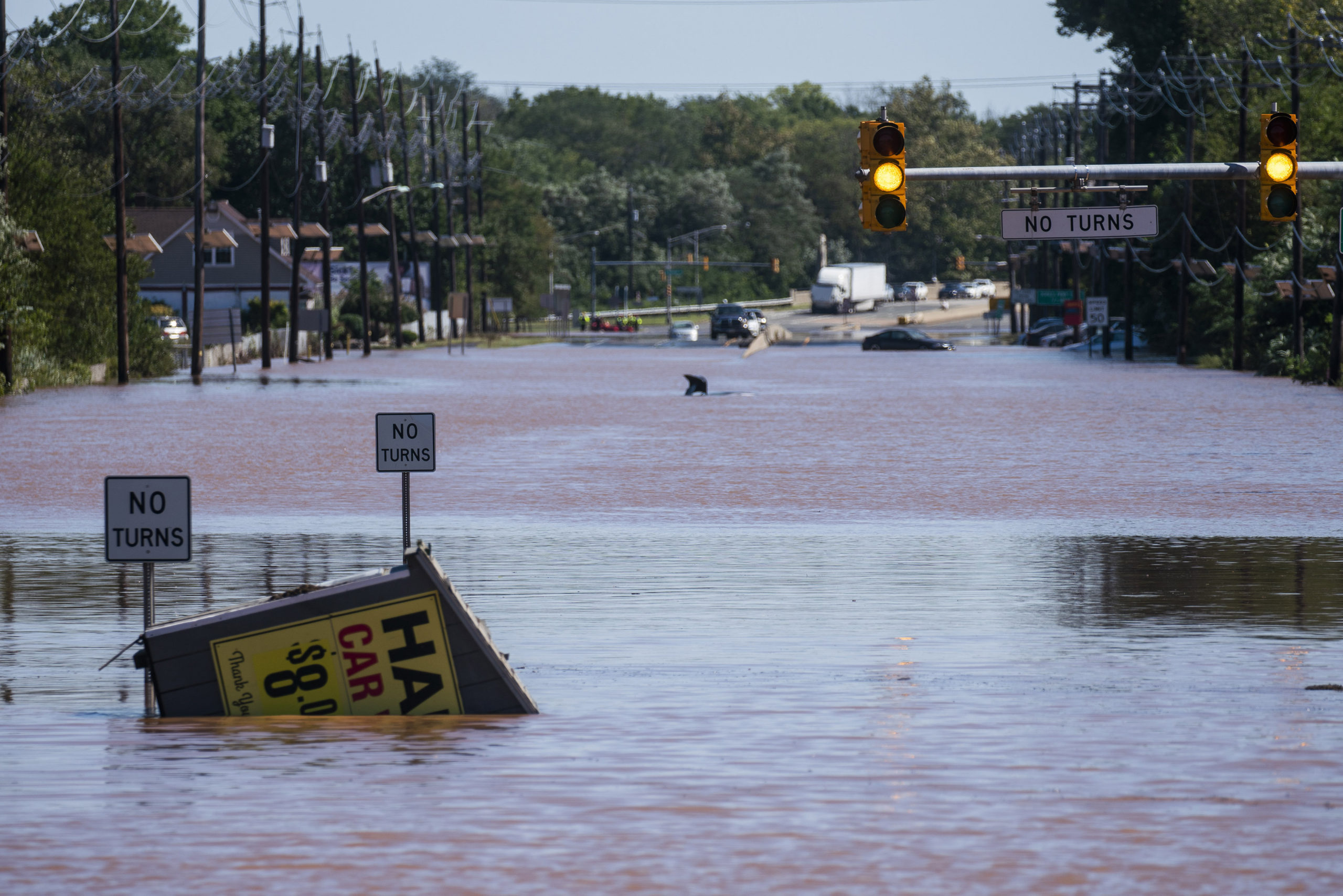
General view of the 206 route partially flooded as a result of the remnants of Hurricane Ida in Somerville, N.J., Thursday, Sept. 2, 2021. Image: Eduardo Munoz Alvarez/AP Photo
“What’s really frustrating is that every different program has different eligibility requirements and determinations,” said Kelly Main, the executive director of Buy-In Community Planning, a nonprofit that helps communities apply for buyouts. “Just being able to go through all of the different eligibility determinations for each of those programs, if you’re a one-person staff in a small town somewhere on the Gulf Coast, is extremely challenging.”
That’s the case for Pauline Okitkun, a tribal administrator of the remote village of Kotlik, Alaska. She often works late into the night to secure grant funding for moving homes in her community of about 650 people to higher ground.
Temperatures in Alaska are increasing more than twice as fast as in the continental U.S., according to the most recent National Climate Assessment. In July 2019, Anchorage, the state’s largest city — which sits just 375 miles south of the Arctic Circle — recorded a record-high temperature of 90 degrees Fahrenheit. As Alaska’s permafrost starts to thaw, sinkholes have swallowed homes and destroyed roads, bridges and other infrastructure, and erosion has eaten away at riverbanks. Many houses in Kotlik hang precipitously over the water as the ground beneath them washes away.
Climate change has also caused more intense and frequent flooding in parts of Alaska, including Kotlik, a riverside community near Pastol Bay in the western part of the state. Okitkun remembers a particularly intense flood in 2013, when water and ice tore down power lines, ripped apart sewage pipes, destroyed the evacuation roads and damaged homes in the village. For days afterward, it was hard to tell where the water ended and the land began.
That’s increasingly the new normal in the region. In 2018, Kotlik flooded five times in nine months, leaving houses teetering on a crumbling riverbank. Without safe housing nearby, some of the remaining homes have become overcrowded. In one case, more than a dozen people are living in a single dwelling.
“Our winters are shorter. They’re a lot warmer,” Okitkun said. “The ice is a lot thinner.”
The increased flooding, fast-paced erosion and permafrost thaw were a wake-up call to the community. In 2018, 82% of Kotlik residents said they supported moving to higher ground, according to a local survey. In 2021, the village put forward plans to move 21 homes — about a sixth of the village — to the site of Kotlik’s old airport, as well as bolster the rapidly eroding shoreline, at an estimated cost of at least $20 million. But obtaining the money has been an uphill battle — one that has fallen largely to Okitkun and the Alaska Native Tribal Health Consortium, which has helped the village apply for grants.
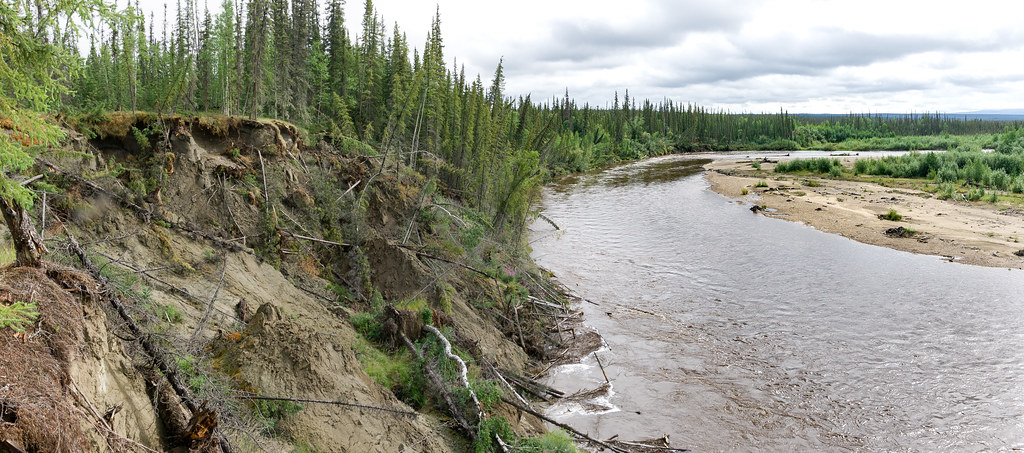
A riverbank collapses due to melting permafrost on lower Birch Creek Wild and Scenic River in Alaska. Birch Creek flows through the lakes and bogs of Yukon Flats for may miles before joining the Yukon River. Image: Craig McCaa/Bureau of Land Management Alaska
This is only the beginning. While Kotlik has prioritized the relocation of the most-threatened homes, the rest of the village also is considering moving to more stable ground as conditions deteriorate.
Okitkun’s experience highlights the challenges vulnerable communities face when seeking relocation assistance from the government. Since 2018, Kotlik has applied for nearly two dozen grants from HUD, FEMA, the BIA and other agencies. In March, the Department of Agriculture announced that it would be providing aid to help Alaskan villages, including Kotlik, move buildings and infrastructure away from flood-prone areas. But the timeline for the assistance and how much money Kotlik could receive is still unclear. So far, the village has secured $2.9 million. That’s less than a fifth of what it needs. Nearly half of Kotlik’s requests for assistance have been rejected.
Here’s why programs related to climate change or hazard mitigation often disadvantage or exclude communities:
First, the government runs grant applications through a cost-benefit analysis to determine whether the projects are worth the federal resources. This is a major hurdle for small towns and villages in Alaska and other parts of the United States, where the number of affected individuals is often small and the cost of infrastructure work can be high. There’s no road access to Kotlik, so equipment and materials must be transported by airplane or boat, increasing costs significantly.
Funding for certain FEMA and HUD grant programs is allocated according to official damage estimates from federally declared disasters. Despite the history of flooding in Kotlik, the area where it’s located has received only one presidential disaster declaration in the past 50 years — in response to the COVID-19 pandemic.
The government’s definition of disasters does not recognize certain hazards exacerbated by climate change, such as permafrost thaw and erosion.
Without official disaster declarations, Kotlik has been ineligible to apply for many federal grant programs.
This is a common challenge in Alaska. Almost 200 Native Alaskan villages suffer from flooding and erosion but do not qualify for federal programs that would help them adapt or recover, according to a 2003 GAO report. That finding was reaffirmed in two subsequent GAO reports, in 2009 and 2022.
Finally, federal grant programs often require local municipalities to pay between 5 and 50% of a project’s cost. That’s prohibitive for many small communities — particularly a village like Kotlik, where the local economy isn’t based primarily on cash and residents rely on traditional subsistence fishing, hunting and gathering.
Kotlik is not alone in its struggles.
In Washington state, where rising seas cause repeated flooding, at least four tribal nations are seeking federal help to support relocation efforts and still need millions of dollars in order to move.
In Colquitt, a small community in Georgia, Hurricane Michael leveled a mobile home park in 2018. Officials applied to FEMA for buyouts twice and received no assistance.
In Horry County, South Carolina, a working-class community just up the coast from Myrtle Beach, residents applied for a HUD-funded buyout program, but the process has dragged on for years, leaving homeowners stranded.
The federal government has no comprehensive record of how many communities across the country have sought relocation assistance and failed to receive it. In August 2021, Columbia Journalism Investigations and its partners filed public records requests with FEMA and HUD, seeking applications from communities that requested aid and were rejected. A year later, despite repeated inquiries, FEMA provided only some of the information and HUD released no documentation.
Because government assistance programs are so difficult to access, communities often find themselves dealing with the aftermath of disasters on their own. In De Soto, Missouri, residents sit in their cars when it rains, ready to evacuate quickly if the Joachim Creek floods. The Army Corps of Engineers recommended buyouts for about 70 flood-prone properties in 2019. Since then, the city has applied for FEMA buyouts twice, but state and federal officials approved funding for just one property. The homeowner chose to remain in their home. No one in De Soto has been moved out of the flood zone.
With no aid on the horizon, some residents have sold their flood-prone houses at a loss. “Right now they’re selling on this block, but they’re selling for 25 cents on the dollar,” said Ken Slinger, a De Soto resident who lives across the street from the Joachim Creek. A federal buyout would allow him and his wife, Cindy, to move to a safer area, he said. Without one, they can’t afford a comparable home nearby.
Residents who do sell face an emotionally and morally fraught decision. It can feel like their only option, but it leaves new homeowners in a precarious position.
“If we did decide to sell, we wouldn’t sell to anyone who had little kids. We wouldn’t sell to elderly people,” Cindy Slinger said. “You’re selling your house in a floodplain, and you’re selling it so somebody else can move in and be impacted.”
For Okitkun, trying to get the Kotlik community in a position to move to higher ground left her exhausted. “It just took a toll on me,” she said.
In February 2021, she quit her job as tribal administrator. But no one else stepped in. A few months later, she was back at it, shouldering the work and the stress.
Where the dead don’t stay buried
While Native villages like Kotlik have been struggling for years to obtain government assistance, many other vulnerable communities across the country aren’t even in a position to apply.
The unincorporated community of Ironton, in Plaquemines Parish, Louisiana, was founded by formerly enslaved people in the late 19th century. Today it remains an almost entirely Black community. Many residents are refinery workers or retirees. All have deep ties to Ironton.
Audrey Trufant Salvant, for example, is a fifth-generation Irontonian. “My family has been there from its conception,” she said, “and I have deep-rooted love for this community.”
But like many small, rural communities of color, Ironton has been overlooked by federal disaster preparedness programs. In the past three decades, 16 major hurricanes hit Plaquemines Parish — six in the past five years alone. Ironton residents can rattle off the names of storms as though they were neighbors: Katrina and Rita came through in 2005, Gustav and Ike in 2008, Isaac in 2012.
Those hurricanes and others prompted an influx of federal dollars across the region. Between 1989 and 2020, Louisiana received more than $3.1 billion in disaster preparedness aid through FEMA, almost one-fifth of the more than $18 billion the government has allocated for these programs nationwide.
But Ironton has received little federal assistance. As an unincorporated town, there’s no local government — no mayor, town manager or local council — to advocate on the residents’ behalf.
Ironton’s residents rebuilt the town on their own after the flooding that Katrina and Isaac caused. In 2021, Hurricane Ida ravaged the community once again. Rushing waters knocked homes off their foundations, tossed aside pews inside the local church that was built in 1880 and destroyed the cemetery, where some of Ironton’s founding residents — the first free Black people to live in the community — are buried.
“My mother’s tomb is intact,” said Rev. Haywood Johnson Jr., the church’s pastor. “But my uncle and my aunt, their coffins were floating.”
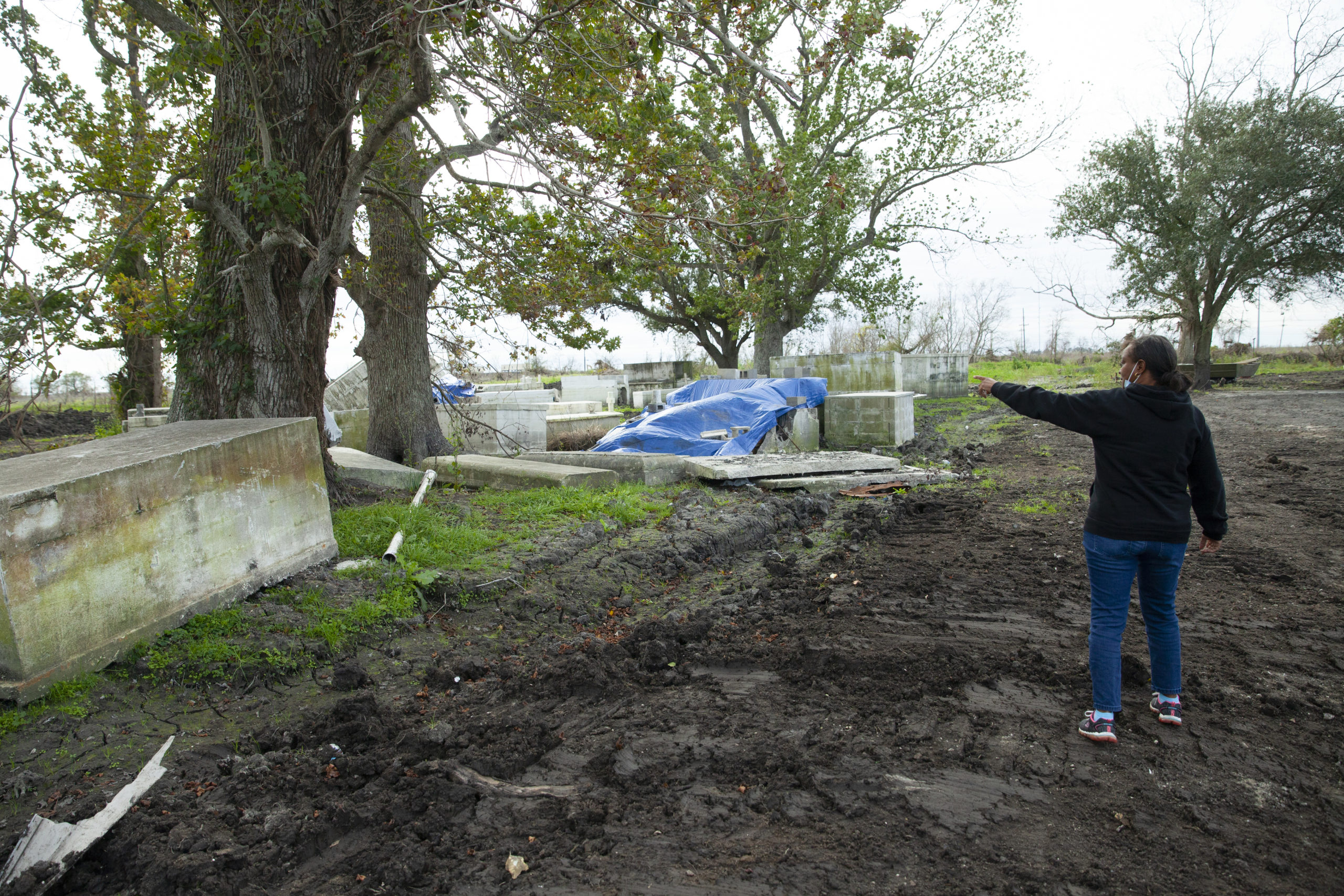
Cassandra Wilson of Ironton, Louisiana, gestures at her community’s cemetery, flooded by Hurricane Ida in 2021. The storm surge pushed caskets out of the crypts. Image: Olga Loginova/Columbia Journalism Investigations
Ironton isn’t alone in its inability to access federal assistance programs.
“Every [buyout] administrator that we’ve talked to tells us about a community that wants to do buyouts and hasn’t been able to, but not usually because they’ve applied to FEMA or HUD and not gotten the money, but because they are unable to apply for the money,” said A.R. Siders, a researcher at the University of Delaware who studies disasters. “They just don’t have the staff or the capacity to do it.”
In 2021, Virginia’s Department of Emergency Management surveyed 40 communities with vulnerable populations that it identified as being at high risk for climate-driven disasters. In response, local officials expressed frustration and exasperation with the federal grant application process. Several had no idea grants were available, and many said they didn’t have sufficient grant-writing expertise or understanding of what the programs were or how they were supposed to work.
“Not an expert in grant programs,” one official wrote in his survey response. “Can’t manage all duties and grant applications.” He was, he said, a “one man show.”
Often the hurdles stem from the ways in which communities have long been disenfranchised. Through the end of the 1960s, for example, Plaquemines Parish was governed by Leander Perez, a staunch segregationist who denied free Black towns like Ironton basic services. Until 1980, the town had no running water.
It’s no surprise that historically marginalized communities like Ironton are now the ones suffering the most from climate-driven disasters, said Robert Bullard, a professor of urban planning and environmental policy at Texas Southern University and a member of the White House Environmental Justice Advisory Council. Across the country, he said, these communities reflect the “racial footprint of infrastructure apartheid” that has persisted throughout America’s history.
“You see those same states, those same counties that 100 years ago you had racial redlining,” Bullard said. “You can see this playing out.”
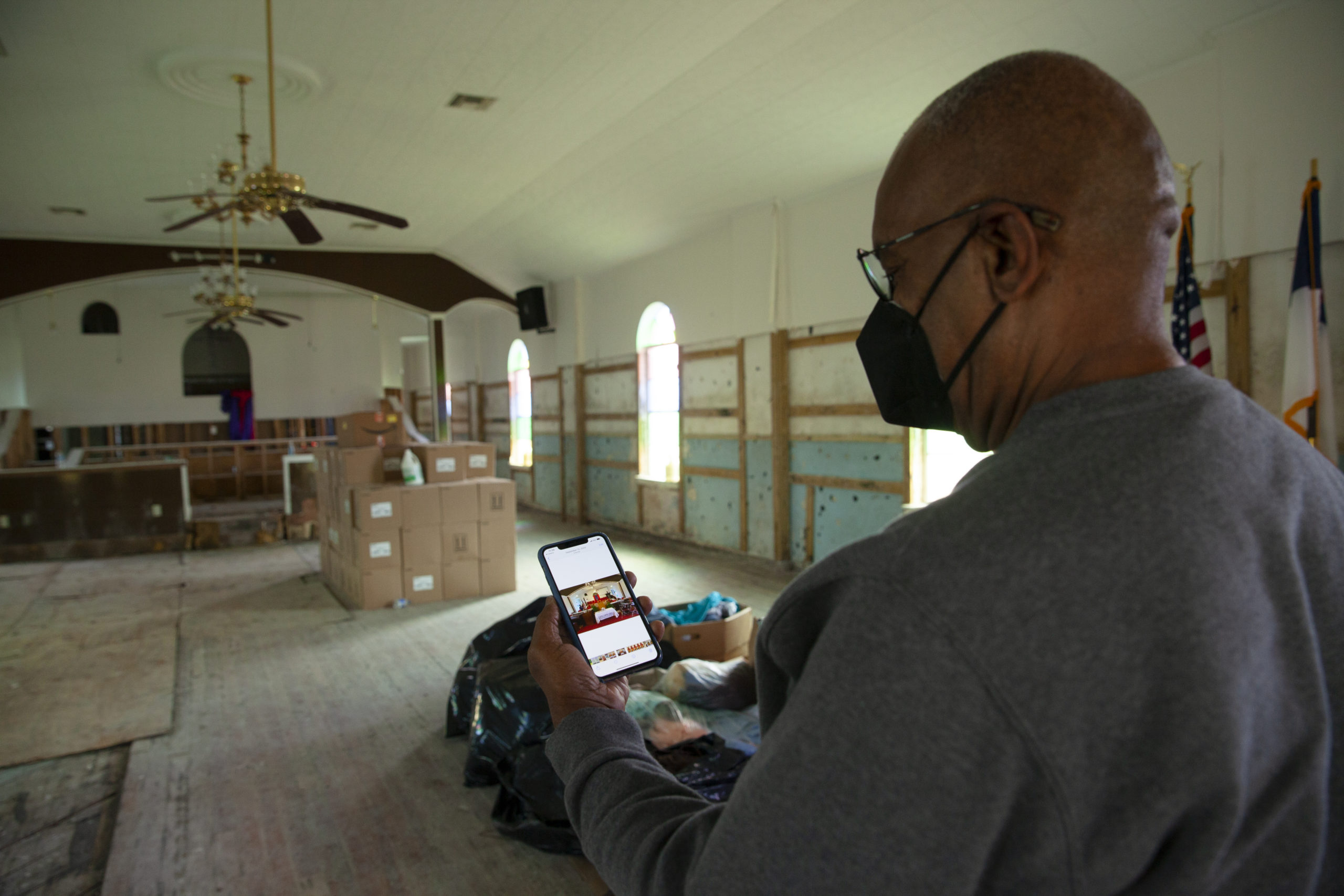
Rev. Haywood Johnson compares a picture of the Saint Paul Missionary Baptist Church taken before 2021’s Hurricane Ida with what he sees in front of him. During the hurricane, the community of Ironton, Louisiana, was flooded with up to 16 feet of water. Johnson and parishioners had to gut the building on their own. Image: Olga Loginova/Columbia Journalism Investigations
In Virginia, for example, counties with a greater share of Black residents were much more likely to have experienced a higher number of hurricanes or floods over the past 30 years. That’s according to an analysis performed by Columbia Journalism Investigations and its partners.
North Carolina counties with a higher poverty rate, or a greater share of Black residents, were also more likely to have been hit by a higher number of these disasters. And Texas counties with a greater share of Black or Latino residents were much more likely to have been struck by a higher number of hurricanes, floods or wildfires.
In the wake of Hurricane Ida, some Ironton residents are considering taking a buyout — not from the government, but from a private company contracted by the Port of Plaquemines Parish, which wants to construct a rail line to move cargo containers through the historic town. The decision about whether to sell is a difficult one, particularly in a community with such historic ties to the area. But having been marginalized for so long, some Ironton residents feel that taking the offer and starting fresh elsewhere might be their only option.
“We’ve been the sacrificial lambs,” said Salvant, who is determined not to sell. “We take the brunt of the storm, take all of the losses, our homes are destroyed. When the federal funding comes in, they utilize it in the northern part of the parish that was barely impacted.”
Plaquemines Parish President Kirk Lepine did not respond to multiple requests for comment.
Unmanaged retreat
The federal government is slowly acknowledging that vulnerable communities need assistance to move out of the way of climate-fueled disasters. The landmark infrastructure bill passed in November 2021 provides the Bureau of Indian Affairs with $130 million for “community relocation” and $86 million for “tribal climate resilience and adaptation projects.”
This funding is a drop in the bucket, however, compared to the hundreds of billions of dollars that will be needed in the coming decades to help millions of people across the country relocate.
According to a 2020 GAO report, each FEMA buyout between 2008 and 2014 cost the federal government an average of $136,000.
But the cost of doing nothing can escalate quickly.
In flood-prone areas, for example, the government might need to provide repeated rounds of aid to help residents recover and rebuild, said Jeffrey Peterson, a former Environmental Protection Agency official and member of the White House Council on Environmental Quality during the Obama administration. The “smarter investment,” he said, is for the government to buy out residents — avoiding the need for additional help.
“We could end up spending $500,000 on your house,” Peterson said. “So let’s buy it now for $250,000” and prevent escalating costs.
Mitigation efforts like seawalls may delay encroaching waters, but they also require large upfront investments. And even then they are only an interim solution, Peterson and other experts warn.
“Protection for most of our coastline doesn’t make any sense,” said Solomon Hsiang, a professor of public policy at the University of California, Berkeley. “For a lot of the U.S. coastline, relocation is probably cost-effective.”
Some federal lawmakers have highlighted the need for more action.
“Climate migration is already happening, and it’s going to be a serious challenge for governments around the world during this century if we don’t quickly chart a new course to lower emissions on a global scale,” said Sen. Sheldon Whitehouse, a Rhode Island Democrat, among those who requested the 2020 GAO report that called for the creation of a climate migration pilot program.
But politicians’ unwillingness to fully acknowledge the problem is a key obstacle to funding relocation efforts, according to interviews with a dozen former federal officials.
“People’s climate risk is not something that politicians, that elected officials, that even appointed officials, or people running different agencies of governments in towns and cities across the country are eager to know and make public — largely because they believe that they do not have the money to address the climate risks that might be revealed,” said Harriet Tregoning, a former senior HUD official who is now director of the New Urban Mobility Alliance, a coalition focused on urban transportation. “And highlighting climate risk without a plan for addressing those risks, they see as a recipe for undermining everyone’s confidence in the future of that community.”
Alice Hill, who until May was President Joe Biden’s nominee to replace Salinas as FEMA’s deputy administrator for resilience, supports developing a federal relocation policy. But doing so is “politically unpalatable,” she wrote in her 2019 book Building a Resilient Tomorrow: How to Prepare for the Coming Climate Disruption.
The most recent effort to develop a plan for climate relocation came in 2016, when President Barack Obama established an interagency working group to craft a framework for “managed retreat,” a term that describes voluntary, community-led relocation projects. The Trump administration abandoned the project after just two months, and the Biden administration has not relaunched it.
Asked for comment, the White House did not address this directly. Its Council on Environmental Quality provided a list of efforts to defend people from climate-fueled disasters, only a few of which were about relocation, and offered a statement from Chair Brenda Mallory.
“The truth is: we need a wide range of strategies and solutions — across the entire Federal government — to help communities protect themselves from disaster, respond when disaster strikes, and, in some cases, move out of harm’s way,” she wrote. “Through a series of hazard-focused interagency working groups, we are working to get critical investments to the communities that are most vulnerable, support community-led efforts to protect against climate-fueled disasters, improve climate and risk information for communities, improve building standards and codes across the country, and share best practices and policies.”
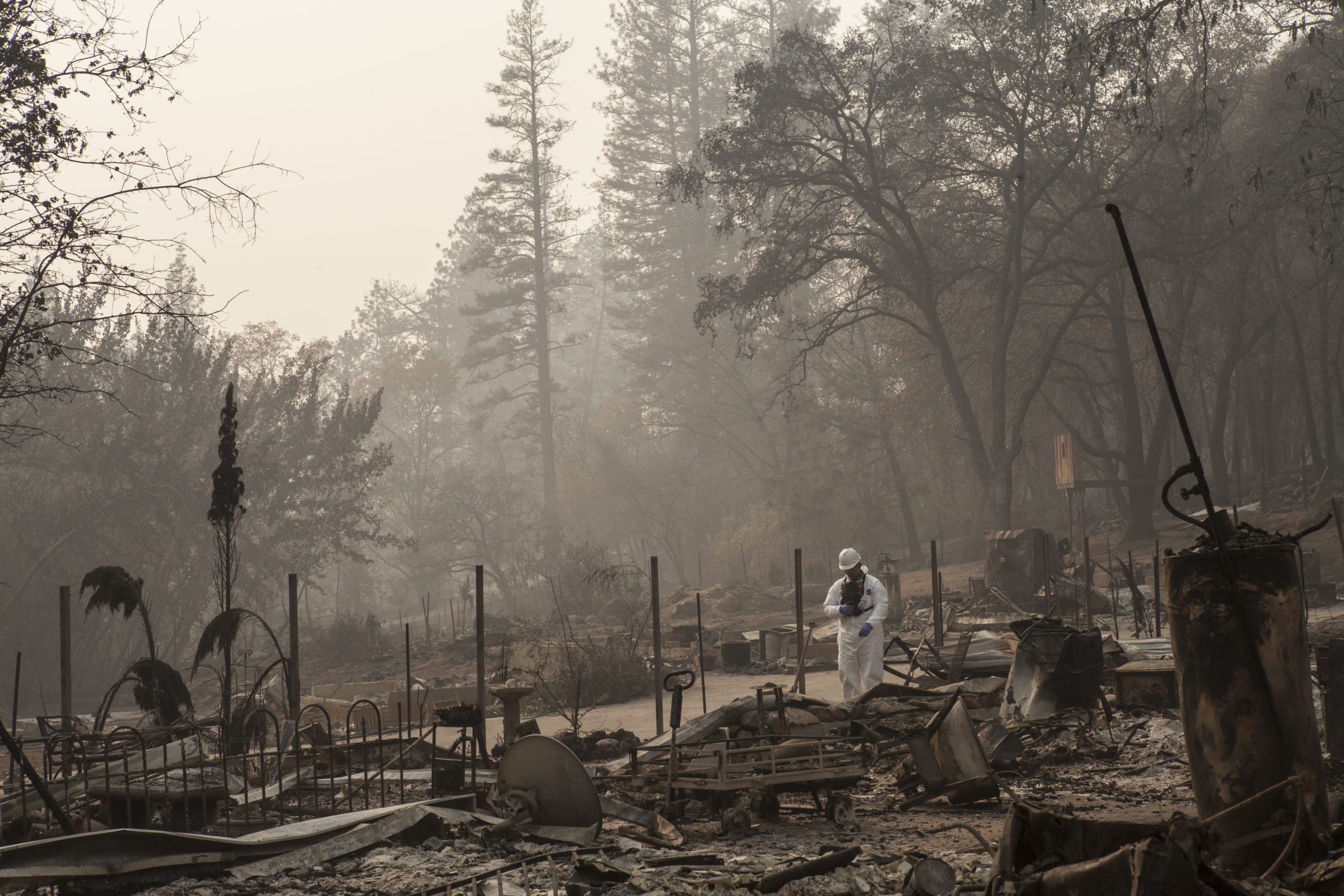
U.S. Army Sgt. Rodrigo Estrada of the California Army National Guard's 649th Engineer Company, 579th Engineer Battalion, 49th Military Police Brigade, from Chico, California, leads a team conducting search and debris clearing operations, Nov. 17, 2018, in Paradise, California. The engineers worked in support of state agencies following the deadly Camp Fire. Image: Senior Airman Crystal Housman/U.S. Air National Guard
Without any federal relocation policy in place, scientists say Americans are already in “unmanaged retreat” — families and individuals are taking matters into their own hands and, without government help, fleeing areas vulnerable to climate-driven disasters.
In Paradise, California, the 2018 Camp Fire, one of the worst wildfires in California history, burned down more than 13,000 structures — 95% of the town. At least eighty-five people died. Sarah Bates, a longtime resident, lost her home and everything in it: photo albums, all of her furniture, the record collection she’d compiled during her 40-year stint as a radio DJ, the electric wheelchair she needed to get around.
After the fire, Bates spent her days in Red Cross shelters, then in a motel FEMA paid for. But in the wake of wildfires, government assistance is almost entirely directed toward rebuilding, not relocating. FEMA offers funding for landscaping and home improvements that can mitigate damage from fires, rather than moving people away from the riskiest areas.
“There’s no precedent for wildfire buyouts,” said Robert Barker, a spokesperson for FEMA Region 9, which includes California.
Some Paradise residents were keenly aware that wildfires could decimate the town. A decade earlier, three major wildfires damaged or destroyed nearly 600 structures in Butte County. During one fire, two evacuation routes were blocked by the blaze, leaving only one road out. Residents hit massive traffic jams as they tried to flee.
That left Bates anxiously watching for signs of imminent disaster. Whenever she heard the rumble of an airplane outside, she said, she dropped everything to see if it was on its way to fight a wildfire nearby.
After the Camp Fire, she decided she could no longer stay. She initially moved to North Carolina before eventually settling in central Virginia, funding the move on her own. To get across the country, she spent three days on trains and buses, then hitched a ride from a friend between Nashville and North Carolina. Once she got to the East Coast, she struggled to find affordable housing.
“There’s still people not in housing even now,” Bates said. “And it’s inexplicable to me that the government has not worked out what to do about helping them get rehomed after three years.”
Thousands of other wildfire survivors are also relocating on their own. More than 14,000 people moved out of Paradise after the Camp Fire, according to Peter Hansen and Jacquelyn Chase, researchers at Chico State University who analyzed change of address data to map the migration across the country. More than 4,000 left Butte County and more than 2,600 left California entirely, moving to Oregon, Indiana, Tennessee and other states, the analysis showed.
The movement of people away from local communities can leave cities and regions hollowed out, with fewer resources for the residents and businesses that remain. But even though community relocation may be politically unpopular, experts say public officials can no longer ignore the need to act.
“The absence of managed retreat is going to be unmanaged retreat,” said Anna Weber, a policy analyst with the Natural Resources Defense Council. “It’s not going to be no retreat at all.”
In April, Valerie Butler, a member of the Smithfield Town Council and one of Betty Ricks’ neighbors, sent an email to the town manager and her fellow council members. In it, she urged her colleagues not to give up on efforts to obtain federal aid for relocation.
“I know the bureaucratic process can be daunting,” Butler wrote. But Smithfield was facing another hurricane season, and residents were frightened. “Can you imagine,” she wrote, “being in your home, a place of protection and safety, when it rains each time and your kids ask you, ‘is the boat going to have to come [and] get us.’
“This is heartbreaking. Resolving this situation should be a priority.”
CJI research assistants Gabriela Alcalde and Samantha McCabe contributed to this story. Carolynne Hultquist, a disaster researcher at Columbia University’s Center for International Earth Science Information Network, contributed to the data analysis.
Julia Shipley, Alex Lubben, Zak Cassel and Olga Loginova are reporting fellows for Columbia Journalism Investigations, an investigative reporting unit at the Columbia Journalism School. The Center for Public Integrity and Type Investigations, two nonprofit investigative newsrooms, provided reporting, editing, fact checking and other support. Additional funding for this story was provided by the Fund for Investigative Journalism.